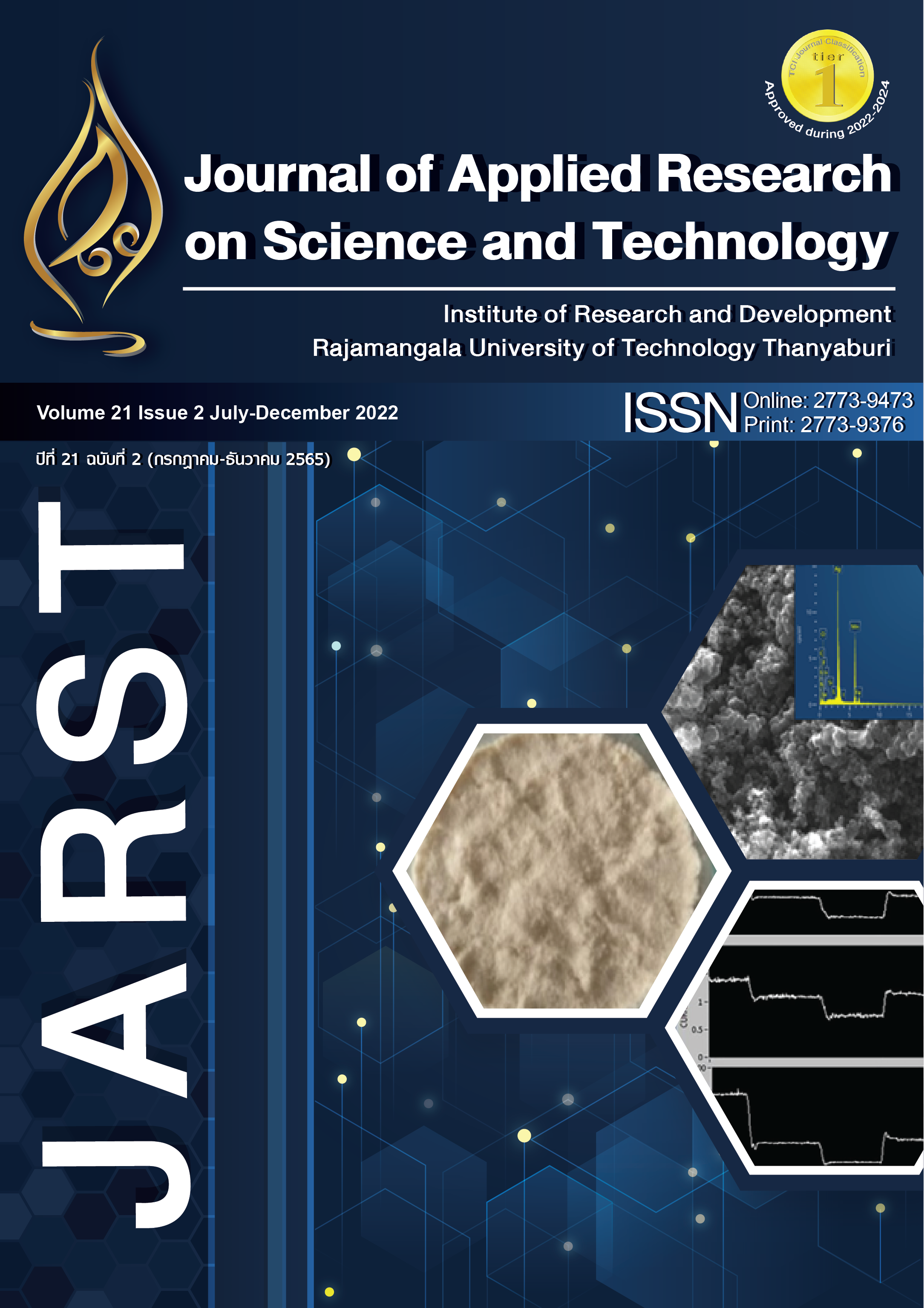Effect of Sugar Content on Physical and Sensory Properties of Tapioca-based Cookies
Main Article Content
Abstract
High sugar intake is associated with negative effects on health of consumers. Tapioca-based cookie (Khanom Ping) is a popular baking product containing high sugar. The sugar, especially sucrose, plays important roles in baked products. However, reformulation may allow an efficient reduction in sugar, whereas it might have an affect product quality and the acceptance of consumers toward products. Therefore, this research aimed to study the effect of sugar content (10%, 15%, 20%, and 30%) on various properties of these cookies. The images of cookies showed an increase in sucrose content resulting in a smoother outer surface, a decrease in the height with a higher spread of cookies and a more porous internal structure. In addition, an increased sugar content resulted in a decrease in the specific volume of the baking pastry while the moisture content decreased. The gelatinization temperature increased with an increase in the sugar level in the formulation. Peak and final viscosities decrease with an increasing sucrose content. Moreover, Cookies containing 10% sucrose resulted in the highest hardness. Sensory data on a 9 point-hedonic scale indicated that the panelists liked cookies that contained 20% sucrose over other samples. The cookie containing 20% sucrose showed the highest score for all sensorial attributes (p<0.05). Therefore, the difference in sugar content ultimately affects the quality of the baked products as well as consumer acceptance, which is an important factor for the recipe design of the low-sugar Khanom Ping.
Article Details

This work is licensed under a Creative Commons Attribution-NonCommercial-NoDerivatives 4.0 International License.
References
Peanthong J, Tanteang O, Keawsritong J, Thanawatchai A. [Product development of Khanom Ping supplement Gotu Kola leaf]. The 2nd Kamphaeng Phet Rajabhat University Student National Conference; 2016 Dec 28; Faculty of Science and Technology, Kamphaeng Phet Rajabhat University, Thailand. p. 808-15. Thai.
Sanyapradit J, Sane A, Sappakul P. Moisture Sorption Isotherm and Texture of Glassy Tapioca-Flour-Based. The 12th ASEAN Food Conference; 2011 Jun 16-18; BITEC Bangna, Bangkok, Thailand, p. 254-9.
Nip W-K. Sweetener. In: Hui YH, editor. Bakery Products: Science and Technology. 1st Edition. Blackwell Publishing Professional Lowa, USA; 2006. p. 137-60.
Gao J, Brennan MA, Mason SL, Brennan CS. Effects of sugar substitution with ‘Stevianna” on the sensory characteristics of muffins. J Food Quality. 2007;2:1-11.
Mariotti M, Lucisano M. Sugar and Sweeteners. In Weibiao Z, Hui YH, editor. Bakery Products Science and Technology. 2nd Edition. Blackwell Publishing Professional, Lowa, USA. 2014. p. 199–220.
Luo X, Arcot J, Gill T, Louie JCY, Rangan A. A review of food reformulation of baked products to reduce added sugar intake. Trends Food Sci Technol. 2019;86:412-25.
Barrett A, Kaletung G, Rosenburg S, Breslauer K. Effect of sucrose on the structure, mechanical strength and thermal properties of corn extrudates. Carbohyd Polym. 1995;26(4):261-9.
Kweon M, Slade L, Levine H. Potential sugar reduction in cookies formulated with sucrose alternatives. Cereal Chem. 2016;93(6):576-83.
Othong J, Klinmalai L, Chareonchai A. [The using of inulin replaced with sugar in milk ice cream supplemented with chicken breast]. J Appl Res Sci Tech. 2020;19(1):39-50. Thai.
AOAC International. Official methods of analysis of AOAC International. 17th ed. 2000.
Hunter EK, Bello FD, Arendt EK. Rheological properties and bread making performance of commercial wholegrain oat flours. J Cereal Sci. 2010;52: 65-71.
Hoseney RC. Chapter 6 Glass transition and its Role in Cereals. In: Delcour JA, Hoseney RC, editor. Principles of Cereal Science and Technology. 3rd Edition. AACC International, Academic Press Ltd-Elsevier Science Ltd. 2010. p. 97-106.
Chevallier S, Colonna P, Lourdin D. Contribution of major ingredients during baking of biscuits dough systems. J Cereal Sci. 2000;31(3):241-52.
Pareyt B, Talhaoui F, Kerckhofs G, Brijs K, Goesaert H, Wevers M. The role of sugar and fat in sugar-snap cookies: Structural and textural properties. J Food Eng. 2009;90:400-8.
Sahin AW, Zannini E, Coffey A, Arendt EK. Sugar reduction in bakery products: Current strategies and sourdough technology as a potential novel approach. Food Res Int. 2019;126,108583: 1-17.
Slade L, Levine H, Wang M. The glassy state phenomenon in applications for the food-industry-Application of the food polymer science approach to structure-function-relationships of sucrose in cookie and cracker systems. J Sci Food Agr. 1993;63(2):133-76.
Clemens RA, Jones JM, Kern M, Lee S-Y, Mayhew EJ, Slavin JL, et al. Functionality of sugars in foods and health. Comprehensive Reviews. 2016;15(3):433-70.
Purlis E. Browning development in bakery products – A review. J Food Eng. (2010);99(3):239-49.
Pareyt B, Delcour JA. The role of wheat flour constituents, sugar, and fat in low moisture cereal based products: A review on sugar-snap cookies. Cri Rev Food Sci Nutr. 2008;48(9):824-39.
Mezreb K, Goullieux A, Ralainirina R, Queneudec M. Effect of sucrose on the textural properties of corn and wheat extrudates. Carbohyd Polym. 2006;19:1-8.
Pongsawatmanit R, Thanasukarna P, Ikeda S. Effect of sucrose on RVA viscosity parameters, water activity and freezable water fraction of cassava starch suspensions. Sci Asia. 2002;28(2):129-34.
Ortiz JAR, Carvalho CWP, Ascheri DPR, Ascheri JLR, Andrade CT. Effect of sugar and water contents on non-expanded cassava flour extrudates. Food Sci Tech. 2010;30(1):205-12.
Kohyama K, Nishshinari K. Effect of soluble sugars on gelatinization and retrogradation of sweet potato starch. J Agric Food Chem. 1991;39:1406-10.
Panghal A, Chhikara N, Khatkar B S. Effect of processing parameters and principal ingredients on quality of sugar snap cookies: a response surface approach. J Food Sci Technol. 2018;55: 3127–34.


